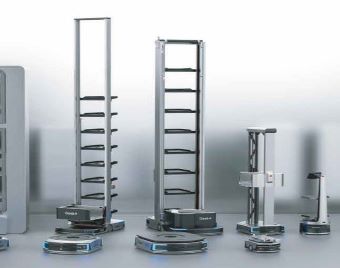More Robots for Less Investment: The Rise of Robotics-As-A-Service
Robotics-as-a-service (RAAS) solves two problems facing many businesses today.
Read More
14.12.2022
The ongoing e-commerce boom continues to impact every element of the warehouse and logistics sector. Growing consumer demand for an ever-expanding range of products and the need for same-day or next-day delivery has driven the need for warehouse managers to re-evaluate their entire operation to find ways to increase pick efficiency and throughput as well as hold more volume of stock to manage possible disruptions in their supply chain.
Picking operations account for more than 55% of a Warehouse or Distribution Centre (DC) costs, so the integration of technology to enhance this activity could provide a solution in these challenging times.

Autonomous Mobile Robots (AMRs) are robots which move independently using natural navigation. Their in-built intelligence allows them to move around a warehouse or DC facility without pre-defined routes or walkways. Using SLAM (Simultaneous Localisation and Mapping) technology AMRs also have the intelligence to avoid any obstacles they might come across by assessing the environment and navigating its own way round it.
Automated Guided Vehicles (AGVs) work independently from warehouse staff and follow pre-defined routes marked out within a warehouse or DC facility to assist with a number of warehouse operations. An AGV is capable of navigating automatically along given tracks however if its sensors detect an obstacle, it will stop and wait for it to be removed before continuing along its agreed route.
Both AMRs and AGVs are available in a range of sizes and functionality depending on the workload they needs to undertake.
In a typical warehouse environment, Autonomous Mobile Robots (AMRs) are becoming increasingly affordable options to automate key warehouse activities, such as picking, replenishment or sortation. Through the use of advanced SLAM technology, AMRs further increase their flexibility in terms of how efficiently they can move throughout the warehouse and also enhance the number of tasks they can complete.
Common AMR activities include:
– Zone picking
– Goods-to-person
– Picking robots
– Flexible sortation
The track or line-dependent AGVs can complete a range of tasks that help to optimise warehouse operations such as increasing inventory accuracy and avoiding mistakes previously caused by human error. For warehouses with a high percentage of pallet handling operations, AGV forklifts can significantly enhance productivity and improve warehouse safety. A simple example of AGV forklifts at work would be:
– Navigate to selected aisle
– Identify SKU location within aisle
– Scan and read product barcode
– Remove pallet from racking
– Transport the pallet to the packing station / dispatch zone
Whilst AMRs and AGVs are not entirely new to the warehouse scene, the recent development of a tranche of lower-cost, simpler-to-implement robots have allowed them to become increasingly accessible to SME-players. Furthermore this type of automation enjoys a wide ranging appeal for warehouse operations across numerous industry sectors such as food & beverage, e-commerce and retail.
AMRs and AGVs have the potential to offer significant benefits to warehouse operations. Alongside enhanced pick efficiency and worker safety, operations can become more agile to cope with sudden changes in stock or delivery requirements. The use of AMRs for example, offers simplified up-and-down scaling made possible through programme adjustments to the integrated software. For the SME market, the deployment of robotics within smaller warehouse facilities has begun to gain significant traction as the technology becomes more cost-effective to warrant investment. With tangible benefits across warehouse operations the use of AMRs and AGVs is set to escalate adding real value to the warehouse of the future through this phenomenally versatile and robust technology.

Robotics-as-a-service (RAAS) solves two problems facing many businesses today.
Read MoreWelcome to the world of seamless warehouse operations, where the introduction of Warehouse Management Systems (WMS) have revolutionised the way inventory is managed, tracked, and distributed.
Read MoreWorkplace design and flexible spaces have become more crucial than ever in catering to the evolving work styles and needs of employees.
Read More